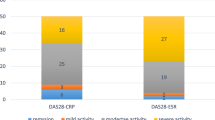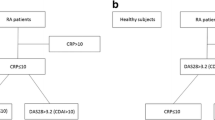Abstract
Objective
The aim of our study was to investigate the contribution of serum calreticulin (CRT) in the assessment of disease activity in rheumatoid arthritis (RA).
Methods
Serum CRT levels were measured by ELISA in 70 patients with established RA, 30 systemic lupus erythematosus (SLE), 25 other autoimmune diseases, 20 osteoarthritis (OA), and 35 of healthy controls (HC). Correlations of CRT serum levels with disease activity [Disease Activity Score for 28 joints (DAS28)], erythrocyte sedimentation rate(ESR) and C-reactive protein (CRP) were assessed. Serum CRT levels were also detected in RA patients whose RF, anti-CCP and anti- MCV antibodies were positive and negative.
Results
Serum CRT levels in RA patients (4.817 ± 2.425 ng/ml) was significantly higher (P <0.05) compared with those in the serum of OA (3.574 ± 0.942 ng/ml), SLE (4.013 ± 1.536 ng/ml), other autoimmune diseases (3.882 ± 0.837 ng/ml) and HC (3.726 ± 0.627 ng/ml). Significant positive correlation of CRT with DAS28, ESR and CRP was found in RA patients. Furthermore, RA patients whose anti-CCP and anti-MCV antibodies were positive had higher levels of CRT (P < 0.01).
Conclusion
Serum CRT levels were increased in patients with RA compared with those controls. Moreover, a significant correlation was observed between serum CRT levels and disease activity in RA. It might be used as a potential biomarker for clinical diagnosis and provide additional information regarding disease activity along with the traditional indices such as ESR and CRP.



Similar content being viewed by others
References
McInnes IB, Schett G. The pathogenesis of rheumatoid arthritis. N Engl J Med. 2011;365:2205–19.
Rindfleisch JA, Muller D. Diagnosis and management of rheumatoid arthritis. Am Fam Physician. 2005;72:1037–47.
Weinblatt ME. Rheumatoid arthritis in 2003: where are we now with treatment? Ann Rheum Dis. 2003;62 Suppl 2:ii94–6.
Emery P. Evidence supporting the benefit of early intervention in rheumatoid arthritis. J Rheumatol Suppl. 2002;66:3–8.
Farheen K, Agarwal SK. Assessment of disease activity and treatment outcomes in rheumatoid arthritis. J Manag Care Pharm. 2011;17:S09–13.
Prevoo ML, van’t Hof MA, Kuper HH, van Leeuwen MA, van de Putte LB, van Riel PL. Modified disease activity scores that include twenty-eight-joint counts. Development and validation in a prospective longitudinal study of patients with rheumatoid arthritis. Arthritis Rheum. 1995;38:44–8.
Nishimoto N, Takagi N. Assessment of the validity of the 28-joint disease activity score using erythrocyte sedimentation rate (DAS28-ESR) as a disease activity index of rheumatoid arthritis in the efficacy evaluation of 24-week treatment with tocilizumab: subanalysis of the SATORI study. Mod Rheumatol. 2010;20:539–47.
Fransen J, van Riel PL. The disease activity score and the EULAR response criteria. Clin Exp Rheumatol. 2005;23:S93–9.
Matsui T, Kuga Y, Kaneko A, Nishino J, Eto Y, Chiba N, et al. Disease Activity Score 28 (DAS28) using C-reactive protein underestimates disease activity and overestimates EULAR response criteria compared with DAS28 using erythrocyte sedimentation rate in a large observational cohort of rheumatoid arthritis patients in Japan. Ann Rheum Dis. 2007;66:1221–6.
Dessein PH, Joffe BI, Stanwix AE. High sensitivity C-reactive protein as a disease activity marker in rheumatoid arthritis. J Rheumatol. 2004;31:1095–7.
Liu X, Jia R, Zhao J, Li Z. The role of anti-mutated citrullinated vimentin antibodies in the diagnosis of early rheumatoid arthritis. J Rheumatol. 2009;36:1136–42.
Zamani B, Jamali R, Jamali A. Serum adenosine deaminase may predict disease activity in rheumatoid arthritis. Rheumatol Int. 2012;32:1967–75.
Metawi SA, Abbas D, Kamal MM, Ibrahim MK. Serum and synovial fluid levels of interleukin-17 in correlation with disease activity in patients with RA. Clin Rheumatol. 2011;30:1201–7.
Eggleton P, Llewellyn DH. Pathophysiological roles of calreticulin in autoimmune disease. Scand J Immunol. 1999;49:466–73.
Goëb V, Thomas-L’Otellier M, Daveau R, Charlionet R, Fardellone P, Le Loët X, et al. Candidate autoantigens identified by mass spectrometry in early rheumatoid arthritis are chaperones and citrullinated glycolytic enzymes. Arthritis Res Ther. 2009;11:R38.
Hong C, Qiu X, Li Y, Huang Q, Zhong Z, Zhang Y, et al. Functional analysis of recombinant calreticulin fragment 39–272: implications for immunobiological activities of calreticulin in health and disease. J Immunol. 2010;185:4561–9.
Johnson S, Michalak M, Opas M, Eggleton P. The ins and outs of calreticulin: from the ER lumen to the extracellular space. Trends Cell Biol. 2001;11:122–9.
Holoshitz J, De Almeida DE, Ling S. A role for calreticulin in the pathogenesis of rheumatoid arthritis. Ann N Y Acad Sci. 2010;1209:91–8.
Ling S, Pi X, Holoshitz J. The rheumatoid arthritis shared epitope triggers innate immune signaling via cell surface calreticulin. J Immunol. 2007;179:6359–67.
Tarr JM, Winyard PG, Ryan B, Harries LW, Haigh R, Viner N, et al. Extracellular calreticulin is present in the joints of patients with rheumatoid arthritis and inhibits FasL (CD95L)-mediated apoptosis of T cells. Arthritis Rheum. 2010;62:2919–29.
Tarr JM, Young PJ, Morse R, Shaw DJ, Haigh R, Petrov PG, et al. A mechanism of release of calreticulin from cells during apoptosis. J Mol Biol. 2010;401:799–812.
Thurlings RM, Vos K, Gerlag DM, Tak PP. Disease activity-guided rituximab therapy in rheumatoid arthritis: the effects of retreatment in initial nonresponders versus initial responders. Arthritis Rheum. 2008;58:3657–64.
da Rocha LF, Jr DÂL, Dantas AT, Mariz HA, Pitta Ida R, Galdino SL, et al. Increased serum interleukin 22 in patients with rheumatoid arthritis and correlation with disease activity. J Rheumatol. 2012;39:1320–5.
Agrawal S, Misra R, Aggarwal A. Autoantibodies in rheumatoid arthritis: association with severity of disease in established RA. Clin Rheumatol. 2007;26:201–4.
Acknowledgments
The authors thank all the subjects for their participation in this study.
Funding statement
This study was supported by the Specialized Research Fund for the Doctoral Program of Higher education funded by the Ministry of Education (MOE, 20101202110008).
Conflict of interest
The authors declare no conflicts of interest.
Author information
Authors and Affiliations
Corresponding author
Additional information
Min Ni, and Wei Wei contributed equally to this manuscript.
Rights and permissions
About this article
Cite this article
Ni, M., Wei, W., Wang, Y. et al. Serum Levels of Calreticulin in Correlation with Disease Activity in Patients with Rheumatoid Arthritis. J Clin Immunol 33, 947–953 (2013). https://doi.org/10.1007/s10875-013-9885-2
Received:
Accepted:
Published:
Issue Date:
DOI: https://doi.org/10.1007/s10875-013-9885-2




